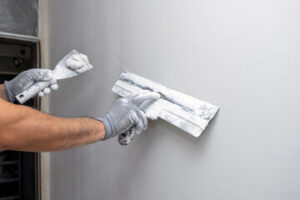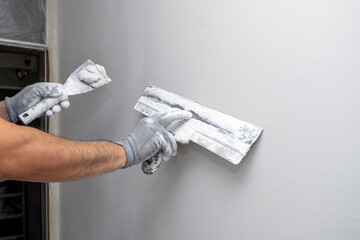Stucco Repair Philadelphia is important because it can lead to serious structural problems if left unattended. It’s a good idea to have these issues repaired as soon as possible.

Costs include labor setup and mobilization, materials, local delivery costs, and service provider markup. This estimate does not include project management costs or other fees associated with planning, scheduling, and directing the work.
When stucco is damaged to the point that it cannot be repaired with a patch, remediation is the only way to restore structural integrity and protect your home. Remediation involves stripping the affected walls, removing sheathing and framing, and replacing them. It can be a lengthy process, but it’s the only option that offers a long-term solution to severe damage. When it’s performed by a skilled team of professionals, remediation can restore your stucco to its original condition and provide renewed safety and peace of mind.
Before making the decision to repair stucco, it’s important to have an expert conduct a full inspection and run moisture tests on your property. These will identify where the damage is occurring and whether it’s caused by water infiltration or by other issues. This assessment will allow you to make an informed decision about the best type of stucco repair to undertake.
If your stucco is showing signs of deterioration, it’s likely that other areas of your home may be suffering from the same problem. If moisture is getting behind the stucco, it can cause unsightly stains and even lead to an infestation of toxic black mold. In addition, moisture can cause rot on the wooden components of your home. This can put your family’s health at risk and be a significant expense to fix.
Stucco repair can be expensive, especially if you have extensive damage. While it can solve a lot of problems, it does not address the underlying issues that can cause structural damage and other complications in your home. If these issues aren’t addressed, they will continue to grow and can potentially put the structural integrity of your home at risk.
Often, the underlying problems that can cause stucco to deteriorate are a result of incorrect materials and installation or improper drainage. Often, this means that your contractor will need to perform other repairs on your building before they can start repairing the stucco. These repairs will typically involve improving drainage, directing water away from the building, and addressing any roof or gutter problems that are contributing to the problem.
Patching
Stucco patching is a straightforward procedure that can bring a damaged wall back to life. Ideally, this type of repair is done in weather that isn’t rainy or too cold. Whether you’re dealing with cracks, holes, or other damage, the first step is to clean the area to remove debris and dirt. Then, make sure the underlying problem is addressed. If there’s moisture or mold present, full remediation is necessary to prevent future problems.
Hairline cracks in stucco can be fixed using a high-quality paintable caulking product. Choose one that contains acrylic additives to help the patch respond to temperature changes and keep it in place. Alternatively, you can purchase a pre-mixed stucco patch at most hardware stores. These products are often offered in quart sizes and can eliminate the steps involved in mixing your own material. Just be sure the patch is specifically formulated for stucco and is marked as sanded; if not, it will not last long.
Before you apply the patch, you’ll need to prepare the area to ensure proper adhesion. This includes removing loose and damaged areas, cleaning the surface to ensure that the patch adheres properly, and roughing up the patch with a float to even it out with the existing wall. If you notice any areas that seem to be leaking, use a wire brush to remove the loose debris, and then lightly mist the patched area with water.
Once the area is prepared, it’s time to apply the first coat. This is known as the “scratch coat” and should be a coarse mixture to help the subsequent layers bond with the damaged plaster. After the scratch coat sets, it’s a good idea to use a notched trowel to create grooves in the mud. This will help the next coat adhere, and it can be any color you want.
Let the scratch coat dry for 24 hours, and then apply a second layer. For best results, apply two or three layers of patch, letting each dry between applications. Once the patch is cured, you can paint over it to match the surrounding stucco.
Filling
Stucco is a durable and beautiful choice for the exterior of homes and commercial buildings. But like all building materials, stucco can deteriorate over time and require repairs. The most common form of damage is cracking. Hairline cracks in stucco are easy to repair, but more extensive damage requires a professional. Inspect your stucco for signs of deterioration to ensure that the problem can be repaired before it gets worse.
Before you begin working on the cracks, it is essential to find and correct the underlying problem that is causing the deterioration. Start by determining how much of the stucco needs to be removed. Loose stucco is easily identified by a hollow sound when you tap it with a hammer. Loose stucco also feels spongey to the touch. You can use a cold chisel to remove loose sections of the stucco, but it is important not to scrape too deeply, as this can lead to more serious problems in the future.
Once the loose stucco is removed, you can apply a new coat of plaster to the wall to fill in any gaps and repair any cracks. Before you apply the plaster, it is important to clean the area and remove any dirt or algae that may be present. After cleaning, wet the surface and use a spray bottle to mist the cracks. This will help the caulk you are about to apply stick better to the surface and prevent it from pulling away from the cracks.
The first step in applying the caulk is to open up the crack by at least one-fourth of an inch. You can do this with a hammer and cold chisel, or you can use a drill with a metal cutting blade. Once you have opened up the crack, brush away any extra debris from the area with a wire brush.
You can then use a drywall caulking gun to apply the Smith & Company Damp Concrete Primer. This product is mixed with water to create a tan emulsion. The emulsion will wet the exposed surface of the crack and flow into the open porosity of the stucco or concrete.
Painting
When a stucco wall is damaged by weather or poor construction, it can lead to a variety of problems. From hairline cracks to blistering walls, these issues can be costly if left unchecked. That’s why it is important to monitor stucco and address any signs of damage as soon as possible.
The first step in any stucco repair job is to determine the cause of the damage. The best way to do this is to look for any areas that are missing texture, chips, or cracks. If you notice any of these signs, it is best to consult with a professional to ensure the problem is handled properly and prevent future damage.
Cracks in stucco are the most common issue homeowners encounter. These can be caused by a number of things, including poor installation, earthquakes, and wind or rain damage. To fix these cracks, you must first make sure there is no standing water or dirt in the cracks. If there are, you should remove the dirt and vacuum the area before starting the repair process. Next, you must sand and clean the surface before applying any patching material.
There are several different patching materials available that are designed specifically for stucco. Some are meant to fill holes, while others can be used on small gouges or cracks. When using these products, you must follow the instructions carefully to ensure proper application. It is also recommended that you buy pigment to match the color of your stucco, since it can change over time.
Once you have applied the patching material, allow it to dry for at least 24 hours before painting. If you wait longer than this, the paint may flake or peel. It is also a good idea to apply several coats of paint to achieve a uniform finish.
Stucco is a beautiful and durable exterior covering that can add character to your home. When it is installed correctly, it can last a long time and stand up to the elements. However, it is important to keep an eye out for any signs of damage and seek out stucco repair services as soon as possible to avoid costly repairs in the future.

